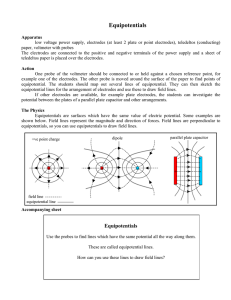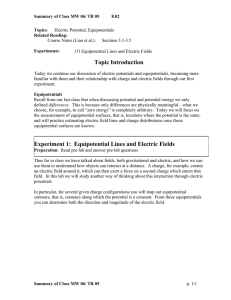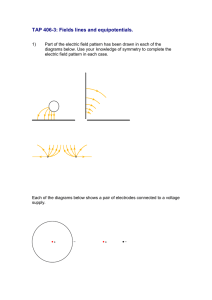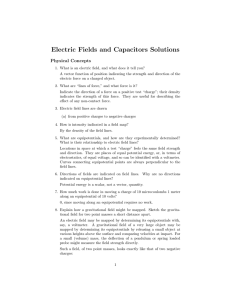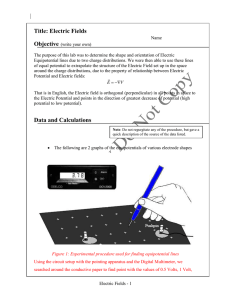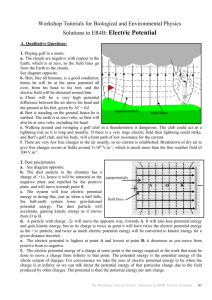Pre-LAB 2 Preparation Electric Potential, Equipotentials, and Electric
advertisement
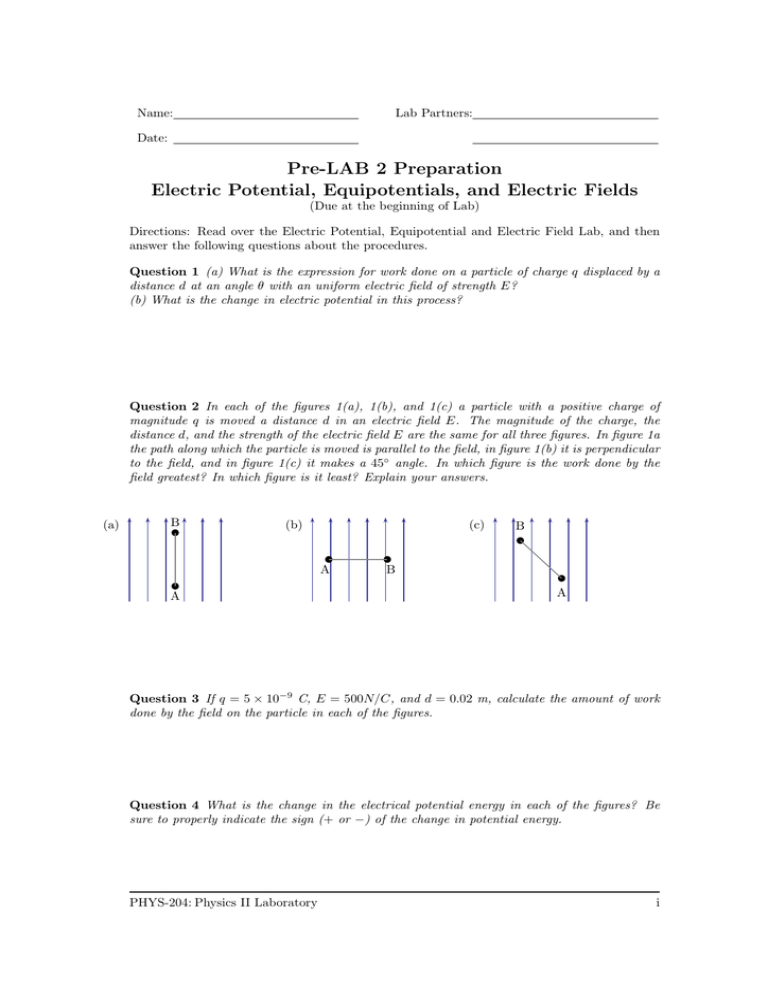
Name: Lab Partners: Date: Pre-LAB 2 Preparation Electric Potential, Equipotentials, and Electric Fields (Due at the beginning of Lab) Directions: Read over the Electric Potential, Equipotential and Electric Field Lab, and then answer the following questions about the procedures. Question 1 (a) What is the expression for work done on a particle of charge q displaced by a distance d at an angle θ with an uniform electric field of strength E? (b) What is the change in electric potential in this process? Question 2 In each of the figures 1(a), 1(b), and 1(c) a particle with a positive charge of magnitude q is moved a distance d in an electric field E. The magnitude of the charge, the distance d, and the strength of the electric field E are the same for all three figures. In figure 1a the path along which the particle is moved is parallel to the field, in figure 1(b) it is perpendicular to the field, and in figure 1(c) it makes a 45◦ angle. In which figure is the work done by the field greatest? In which figure is it least? Explain your answers. (a) B (b) (c) A A B B A Question 3 If q = 5 × 10−9 C, E = 500N/C, and d = 0.02 m, calculate the amount of work done by the field on the particle in each of the figures. Question 4 What is the change in the electrical potential energy in each of the figures? Be sure to properly indicate the sign (+ or −) of the change in potential energy. PHYS-204: Physics II Laboratory i Equipotentials v 0.1 Question 5 If E = 500 N/C and d = 0.02 m, calculate the electric potential difference between points A and B in each of the figures 1a, 1b, and 1c. Question 6 What is the definition of equipotential surface? PHYS-204: Physics II Laboratory ii Name: Lab Partners: Date: LAB 2 Electric Potential, Equipotentials, & Electric Fields Objectives • To review the definitions of work and potential energy, and to apply these definitions in the context of electrical forces. • To understand the definition of electric potential, or voltage. • To learn how to map equipotentials. Overview If you lift a particle from one point to a higher point against the pull of a gravitational field, the gravitational potential energy of the particle increases. This increase in the particles potential energy is equal to the amount of work you have done. ∆PEgrav = W Similarly, if you push a charged particle from one point to another against the force of an electric field the electrical potential energy is increased, and you have to do an amount of work equal to the electrical potential energy difference: ∆PEelec = W Conversely, when a particle falls from one point to another in a gravitational field, the gravitational field does work on the particle, the gravitational potential energy decreases, and the gravitational potential energy difference is negative. When an electrically charged particle moves from one point to another due to an electric field, the field does work on the particle, and the electrical potential energy difference is negative. These labs have been adapted from the Real Time Physics Active Learning Laboratories [1]. The goals, guiding principles and procedures of these labs closely parallel the implementations found in the work of those authors [1, 2]. Investigation 1: Work, Electric Potential Energy, and Potential Difference In Physics I, we defined work in terms of the force required to move an object, the displacement through which the object is moved, and the angle between the force and the displacement: W = F · d = F d cos θ The magnitude of the force exerted on a positively charged particle by an electric field is F = qE. For a positively charged particle, the force is in the direction of the electric field. PHYS-204: Physics II Laboratory 1 Equipotentials v 0.1 Activity 1.1: Work Done on a Charge Traveling in a Uniform Electric Field Questions 1-1, through 1-7 should be answered before coming to class. Note that some of these questions are in the pre-lab assignment. Question 1.1 In each of the figures 1(a), 1(b), and 1(c) a particle with a positive charge of magnitude q is moved a distance d in an electric field E. The magnitude of the charge, the distance d, and the strength of the electric field E are the same for all three figures. In figure 1(a) the particle is moved parallel to the field, in figure 1(b) it is moved perpendicular to the field, and in figure 1(c) it is moved at a 45◦ angle. In which figure is the work done by the field greatest? In which figure is it least? Explain your answers. (a) B (b) (c) A A B B A Question 1.2 If q = 5 × 10−9 C, E = 500 N/C, and d = 0.02 m, calculate the amount of work done by the field on the particle in each of the figures. Question 1.3 What is the change in the electrical potential energy in each of the figures? Be sure to properly indicate the sign (+ or −) of the change in potential energy (Note: if the work done by the field is positive, then the field has used up energy to do this work, so the change in potential energy is negative.) The electric potential difference is defined as the electrical potential energy difference per unit charge: ∆V = ∆PE/q The unit of electric potential difference is the Volt. One volt corresponds to 1 Joule/Coulomb. Question 1.4 If E = 500 N/C and d = 0.02 m, calculate the electric potential difference between points A and B in each of the figures 1(a), 1(b), and 1(c). PHYS-204: Physics II Laboratory 2 Equipotentials v 0.1 Question 1.5 Do you need to know the amount of charge, q, in order to answer question 1-4? Why or why not? Question 1.6 In each of the figures, which point is at the higher electric potential, A or B? Explain. Question 1.7 If the charge q were negative instead of positive, would your answers to question 1.6 stay the same? Measuring Potential Differences between two points in an electric field In this activity you will measure the electric potential difference between between pairs of points in the electric field set up by pairs of conducting electrodes. To make these measurements you will need the following equipment: • Computer-based laboratory system. • Experiment configuration files. • 2 differential voltage sensors. • Water tray. • Electrodes mounted on a plastic grid. • Signal generator set to 60 cycles per second frequency. • Two stiff wires to use as probes. One of the sets of electrodes is a pair of bars mounted on a plastic grid as shown in Fig. 2. + − Figure 2: Two parallel Conducting Plates PHYS-204: Physics II Laboratory 3 Equipotentials v 0.1 This arrangement simulates two parallel conducting plates. This is an important arrangement because it gives a uniform electric field in the region between the plates away from the ends. Step 1: Place this set of electrodes in the tray, and pour in enough water to come up about 1/4th of an inch over the plastic grid. Step 2: A clear plastic sheet has been cut out to go over these electrodes. Place it so that it lies flat on top of the plastic grid. Step 3: Open the file L3A1 2 (Potential Differences). This file will display two meters that will be used to measure potential difference. Step 4: You have two differential voltage sensors, one connected to input 1, the other connected to input 2. Connect the voltage probes, if they are not already connected. Clip the leads of each of the voltage sensors together to assure that the potential differences between the leads are zero. Click the zero button, and zero all sensors. Step 5: Connect the signal generator to the two electrodes. The red post on the signal generator is considered positive; connect it to the electrode marked +, and connect the black terminal to the electrode marked −. Step 6: Note that the leads connected to the voltage sensors are marked + and −, with the red lead corresponding to +, the black to −. Connect voltage probe 2 with the red clip on the positive electrode, and the black clip on the negative electrode. Turn on the signal generator and adjust the frequency to 60 cycles per second. Then turn up the amplitude so that meter 2 reads 6 volts. Note, the meter takes a few seconds to adjust itself to the correct reading. Adjust the amplitude slowly enough that the meter reading can keep up. Step 7: You will use the two stiff wires as probes to determine the potential difference between pairs of points. Clip the bare copper ends of these wires to the two leads of voltage sensor 1. Comment: In a device that measures potential difference, + refers to the higher potential, and − to the lower potential. If the voltage sensor gives a positive value with the − probe at A and the + probe at B, then we consider the potential difference from A to B to be positive. Note the order is important. We would say the potential difference from B to A is negative. Step 8: Measure the electrical potential difference from point A to point B by placing the tip of the negative probe on point A, and the tip of the positive probe on B. Enter your measured value in the Table 1. Hold the probes so that the wires are vertical. If they are angled you will get inaccurate readings. Potential Difference Work on 2 × 10−6 C charge. A to B B to C C to D Table 1: Step 9: Now measure the electrical potential difference from point B to point C, placing the negative probe on B, and the positive probe on C. Enter your measured value in Table 1. PHYS-204: Physics II Laboratory 4 Equipotentials v 0.1 Continue by measuring the potential difference from C to D and enter your value into Table 1. Question 1.8 How large is the total potential difference from point A to point D? Question 1.9 How much work would be needed to move a particle with charge 2 × 10−6 C from point A to point B? B to C? C to D? Calculate the amounts of work, and enter them in Table 1. Question 1.10 What would be the total work needed to move a particle with charge 2 × 10−6 C from point A to point D? Total work A to D = Joules Question 1.11 As the charged particle is moved from A to D, does its potential energy increase or decrease? By how much does the potential energy change? Prediction 1.1 Suppose you were to move the charged particle from A to D along the straight line going from A through points E and F to D. Would the total amount of work be the same? Would you determine the same potential difference between points A and D? Step 10: Check your predictions. Using the same technique as in steps 8 and 9, measure the potential difference from A to E, E to F, and F to D, and enter your measured values in Table 2. Potential Difference Work on 2 × 10−6 C charge. A to E E to F F to D Table 2: Question 1.12 What is the total potential difference from A to D along the path through E and F. Does your measurement agree with your prediction? Because of the limits in PHYS-204: Physics II Laboratory 5 Equipotentials v 0.1 precision of the equipment, you should consider any discrepancies smaller than a few hundredths of a volt to be insignificant. Is it reasonable to expect that the amount of work needed to move a particle from A to D would be the same along any path? Why or why not? Prediction 1.2 What is the electrical potential difference from B to E? Realize that the precision of the equipment is no better than about a tenth of a volt. Can you tell with certainty which point, B or E, has the higher potential? Step 11: Check your prediction using the probes to measure the potential difference from B to E. Question 1.13 Does your measurement agree with your prediction? Because of the limits in precision of the equipment, you should consider any reading smaller than a few hundredths of a volt to be a potential difference of 0. Prediction 1.3 What is the electrical potential difference from C to F? Can you tell with certainty which point, C or F, has the higher potential? Step 12: Check your prediction using the probes to measure the potential difference from C to F. Question 1.14 Does your measurement agree with your prediction? Because of the limits in precision of the equipment, you should consider any reading smaller than a few hundredths of a volt to be a potential difference of 0. Question 1.15 From your measurements in this activity will the difference of potential be maximum when the particle moves along the field or perpendicular to the field? PHYS-204: Physics II Laboratory 6 Equipotentials v 0.1 Question 1.16 From your measurements in this activity will the difference of potential be zero when the particle moves along the field or perpendicular to the field? Investigation 2: Exploring Equipotentials In any arrangement of charges there are many points that have the same electric potential. We call the set of all these points an equipotential. These equipotentials give us one way to map out the electric field set up by the arrangement of charges. In this investigation you will explore the equipotentials for few different arrangements of electric charge represented by different electrodes. Activity 2.1: Sketches of equipotentials Question 2.1 Suppose that you are a test charge and you start moving at some distance from the charge in Fig. 3 (such as 1 cm). (a) What path could you move along without doing any work? That is, what path would you take so that the work is always zero? (hint: check your answer to Questions 1.15 and 1.16) (b) Using the answer to (a) indicate what the shape of the equipotential surfaces around the point charge represented in Fig. 3 is. Remember that in general you can move in three dimensions. Question 2.2 Sketch some equipotential surfaces for the configuration of two charged parallel plates shown in Fig. 4, which consists of two charged metal plates placed parallel to each other. What is the shape of the equipotential surfaces? Question 2.3 Sketch some equipotential surfaces for the electric dipole charge configuration shown in Fig. 5 PHYS-204: Physics II Laboratory 7 Equipotentials v 0.1 + Figure 3: Electric Field from a Point Charge − − − − − − − − − − + + + + + + + + + + Figure 4: Electric Field Between Parallel Conducting Plates Question 2.4 In general, what is the relationship between the direction of the equipotential lines you have drawn (representing that part of the equipotential surface that lies in the plane of the paper) and the direction of the electric field lines? Activity 2.2: Mapping out equipotentials experimentally In this activity you will use the voltage probes to map out the equipotentials for the arrangements that you worked with in Activity 2.1. You will use the same equipment as in Activity 1.2 Step 1: One of the sets of electrodes has a post at the center, surrounded by a brass ring on a plastic grid as shown in Fig. 6. The center post simulates a point charge. We will think of the outer ring as being ”far away,” where it is customary to take the electrical potential to be zero (this is a slight approximation). Since the center post will be made positive, the electric field lines should be directed radially outward. Place this set of electrodes in the tray, and make sure the tray has enough water to come up about 1/4th of an inch over the plastic grid. PHYS-204: Physics II Laboratory 8 Equipotentials v 0.1 + − Figure 5: Electric Dipole Field − + Figure 6: Coaxial Conducting Shells Step 2: You will use the same file as in Activity 1.2, file L3A1 2 (Potential Differences). Step 3: Clip the leads of each of the voltage sensors together to assure that the potential differences between the leads are zero. Click the zero button, and zero all sensors. Step 4: Connect the positive (red) terminal of the signal generator to the center post, and connect the negative (black) terminal to the outer brass ring. This way the center post can be thought of as a positive point charge. Step 5: Connect voltage sensor 2 with the negative lead of voltage sensor 2 to the outer ring, and the positive lead to the center post. Turn on the signal generator and adjust the frequency to 60 cycles per second. Then turn up the amplitude so that meter 2 reads 6 volts. Adjust the amplitude slowly enough that the meter reading can keep up. Step 6: You will use voltage sensor 1 to locate points that have the same potential. Connect the negative lead of voltage sensor 1 to the outer ring. Clip the positive lead to the bare PHYS-204: Physics II Laboratory 9 Equipotentials v 0.1 copper end of one of the stiff wires. Step 7: Use the stiff wire as a probe. Search in the area within the ring to locate a point that has an electric potential of 1 Volt. Plot the position of the point on the graph paper showing this arrangement of electrodes. (If you have difficulties finding a point with an electric potential of 1 Volt try finding a point with electric potential of 2 Volt). Step 8: Continue locating and plotting points with the same potential as in the previous question. Until you have enough points to draw a curve that will represent all the points having that same potential as in the previous question. This is the one (or two) volt equipotential. Label the curve ”1 (or 2) Volt.” You should not have to find a lot of points, if you recognize that there is symmetry. Step 9: Repeat the process of locating and plotting points to draw the 2 Volt, 3 Volt, 4 Volt, and 5 Volt equipotentials. Be sure you label the equipotentials. Step 10: Now disconnect the leads to the voltage sensors from the electrodes, and replace the electrodes with the set with two parallel bars. + − Figure 7: Two parallel Bars Adjust the amplitude of the signal generator so that voltage sensor 2 reads 6 volts. Repeat the process of locating the 1, 2, 3, 4 and 5 Volt equipotentials, as in steps 7 through 9. Plot them on graph paper showing the two parallel bars. You should focus primarily on the region between the two bars, but locate some points beyond the end of the bars so that you can see how the equipotentials spread out. Step 11: Finally, replace the parallel bars with the set of electrodes consisting of two posts. − + Figure 8: Two Posts: An Electric Dipole This arrangement of electrodes gives us an electric dipole. Take care to note which post is connected to the positive terminal of the power supply, and which is connected to the negative. Mark them on the graph paper you will use to plot the equipotentials. Again locate the 1, 2, 3, 4 and 5 volt potentials. PHYS-204: Physics II Laboratory 10 Equipotentials v 0.1 Question 2.5 Compare your plots for each of these configurations with the sketches you made to answer Questions 2.1, 2.2 and 2.3. Is there general agreement between the sketches and your experimental plots? If there are differences, which plots are different, and how are they different? References [1] David R. Sokoloff, Priscilla W. Laws, Ronald K. Thornton, and et.al. Real Time Physics, Active Learning Laboratories, Module 3: Electric Circuits. John Wiley & Sons, Inc., New York, NY, 1st edition, 2004. [2] Priscilla W. Laws. Workshop Physics Activity Guide, Module 4: Electricity and Magnetism. John Wiley & Sons, Inc., New York, NY, 1st edition, 2004. PHYS-204: Physics II Laboratory 11
